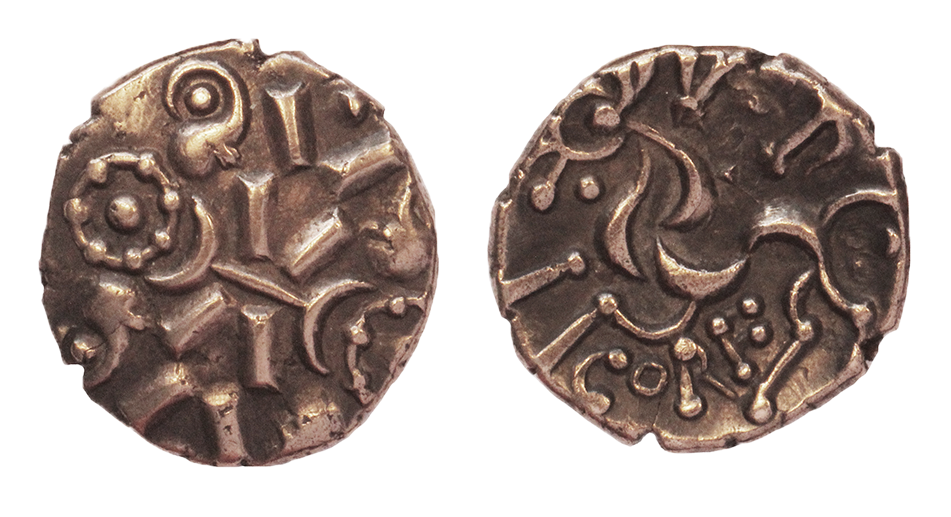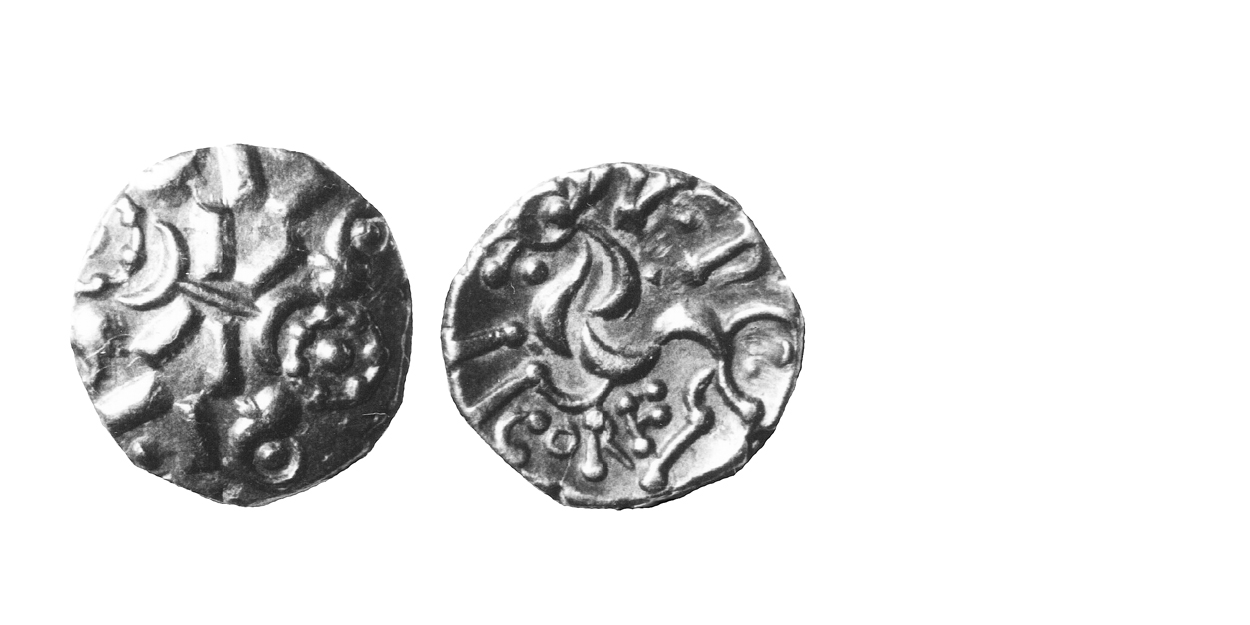
About the Coins
Art (Info)
Inscriptions
Legends first appear on the staters of Commius, the Atrebatic leader closely allied with the Romans during most of the Gallic War. When he came to Britain, he placed his name on the coinage, a practice he undoubtedly learned from Caesar. Other Celtic rulers, not to be outdone, soon copied the idea.
The appearance of inscriptions in one sense makes the coins more interesting and informative. They give the names of rulers who would otherwise be lost to history, and names of mints are identified as well, confirming their exact locations. But the adoption of inscriptions represents a loss as well. An intrusion in the Celtic designs, they look out of place and ruin the artistic effect. Ultimately, the inscriptions become so important to the Celts, the design becomes subservient. They take over an increasing share of the available space, cramping the graphics into a diminished area. The artistic treatment degenerates to the extent the legend is emblazoned across the entire field on some coins the beautiful Celtic design completely eliminated.
Titles and Epithets
Titles seldom occur, but a few appear very late. The first is the RIGON or RICON of Tasciovanus, the Celtic form of REX, meaning king. RIG also appears on the Dobunnic staters of ANTED. Eppillus becomes the first to use the title REX in its Latin form, about the turn of the millennium and Cunobeline and Verica continue the practice.
Romanized Horses
The abstract rendition of the horse, a standard feature of the earliest British staters, disappeared gradually from the coinages of the southern tribes after the war. The Whaddon Chase stater had one of the earliest attempts at a more representational portrayal (93) and eventually the other southern tribes struck coins with Romanized horses. However, the peripheral tribes – the Dobunni Iceni and Corieltauvi – continued highly stylized horses up to the end of their coinages. These three had less direct contact with the Romans and were evidently less willing to modify their artistic heritage.
Direct Copying of Roman Coins
Some coins of Tasciovanus and Cunobeline, both in silver and bronze, were copied directly from the denarii of Augustus. On these, the portrait bust of the emperor is copied exactly, but the name of Tasciovanus or Cunobeline is inserted in place of that of Augustus. On others, the entire reverse design has been lifted and used on the tribal issue. It is important to note this level of artistic decline does not occur on the gold issues, which continue to bear Celticized images. Again, the need for coins of high intrinsic value to pass in commerce without problems dictated a conservative approach.
Designs Adapted from Engraved Gemstones
The classical themes on certain late coins never appear on Roman or Greek coins. Exact parallels exist, however, on engraved gemstones (94). Evidently, the Celts received intaglios from Roman traders in the century before the Roman invasion and used these as models for some of their coins.
Several coin designs of Tasciovanus and Cunobeline are duplicates of known gemstones. A bronze of Tasciovanus with a Centaur playing the double-pipes is one example and another is the seated sphinx on a silver coin of Cunobeline. The running boar on the silver of Epaticcus and the swimming Hippocamp on a silver piece of Adminius are very late examples.
These coins demonstrate how surprisingly innovative the Celtic die-cutters were in seeking out images for the coins. It is possible other sorts of objects may have been reviewed, Roman votive statuary, for example. The sources of inspiration from the Classical world are not yet fully explored and present many opportunities for original work for collectors and students of the series.
It is wrong, however, to think the Celts were incapable of finding artistic inspiration within their own culture. They created images using Celtic models also, although the examples are more difficult to point out. Perhaps the fascination of the interaction between Celtic and Roman society has caused an over-emphasis on the adaptation of Roman motifs. A balanced view acknowledges the inspiration the Celts found in scenes from daily life. These images are clearly neither Roman nor Greek, but purely Celtic in origin.
Next Section – Scenes from Celtic Life

